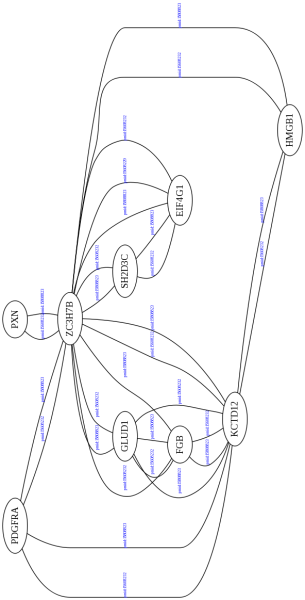EMBL/Strings: find interactors at 2 degrees of separation my notebook.
Thank (again) to the Life Scientists on FriendFeed I've discoreved the API of STRING8 ( STRING 8—a global view on proteins and their functional interactions in 630 organisms NAR 2008): STRING is a database and web resource dedicated to protein–protein interactions, including both physical and functional interactions..
I've used this API to find the partners of a protein at two degrees of separations, here is my notebook:
First download the network for each protein (Note : the database is also available for download) using their HTTP-based API: e.g.: http://string.embl.de/api/psi-mi/interactions?identifier=Roxan. The Ensembl gene ID seems to be the more efficient (non ambiguous) identifiers (e.g. http://string.embl.de/api/psi-mi/interactions?identifier=ENSP00000263243). Note that the STRING database is available for download.
I also wrote a basic XSLT stylesheet transforming the PSI/XML to graphiz-dot format. The stylesheet is available here: http://code.google.com/p/lindenb/source/browse/trunk/src/xsl/psi2dot.xslt. e.g:
Another XSLT stylesheet (psi2sql.xslt creates the statements to insert one or more psi file into a mysql database ).
xsltproc --stringparam temporary "" psi2sql.xslt interaction2.xml | mysql -u login --password=password -D database -N
xsltproc --stringparam temporary "" psi2sql.xslt interaction3.xml | mysql -u login --password=password -D database -N
The parameter temporary is an argument for the stylesheet telling mysql not to work with temporary tables.
Two of the tables created (interactions and interactors) are described below:
+------------+--------------+------+-----+---------+----------------+
| Field | Type | Null | Key | Default | Extra |
+------------+--------------+------+-----+---------+----------------+
| id | int(11) | NO | PRI | NULL | auto_increment |
| pk | varchar(50) | NO | UNI | NULL | |
| shortLabel | varchar(255) | YES | | NULL | |
| fullName | text | YES | | NULL | |
+------------+--------------+------+-----+---------+----------------+
mysql> desc interaction;
+----------------+--------------+------+-----+---------+----------------+
| Field | Type | Null | Key | Default | Extra |
+----------------+--------------+------+-----+---------+----------------+
| id | int(11) | NO | PRI | NULL | auto_increment |
| interactor1_id | int(11) | NO | MUL | NULL | |
| interactor2_id | int(11) | NO | MUL | NULL | |
| unitLabel | varchar(50) | YES | | NULL | |
| unitFullName | varchar(100) | YES | | NULL | |
| confidence | float | YES | | NULL | |
| experiment_id | int(11) | NO | MUL | NULL | |
+----------------+--------------+------+-----+---------+----------------+
7 rows in set (0.00 sec)
And here are the mysql statements finding the protein linked to EIF4G1 at two degrees of separation:
create a temporary table containing a the 2-deg interactions.
(
id1 int,
id2 int,
id3 int
);
insert into t1(id1,id2,id3)
select distinct
P1.id,P2.id,P3.id
from
interactor as P1,
interactor as P2,
interactor as P3,
interaction as I1,
interaction as I2
where
P1.shortLabel="EIF4G1" and
P3.shortLabel!="EIF4G1" and
((P1.id= I1.interactor1_id AND P2.id= I1.interactor2_id) or (P2.id= I1.interactor1_id AND P1.id= I1.interactor2_id)) and
((P2.id= I2.interactor1_id and P3.id= I2.interactor2_id) or (P3.id= I2.interactor1_id and P2.id= I2.interactor2_id))
;
Remove the simple interactions from the temporary table:
t1,
interactor as P1,
interactor as P3,
interaction as I1
where
((t1.id1=P1.id and t1.id3=P3.id) or (t1.id1=P3.id and t1.id3=P1.id)) and
((P1.id= I1.interactor1_id and P3.id= I1.interactor2_id) or (P3.id= I1.interactor1_id and P1.id= I1.interactor2_id))
;
And dump the results:
P1.shortLabel as "Partner1",
P2.shortLabel as "Partner2",
P3.shortLabel as "Partner3"
from
t1,
interactor as P1,
interactor as P2,
interactor as P3
where
t1.id1 = P1.id
and
t1.id2 = P2.id
and
t1.id3=P3.id
;
Here is the result:
EIF4G1 ZC3H7B HMGB1
EIF4G1 ZC3H7B KCTD12
EIF4G1 ZC3H7B FGB
EIF4G1 ZC3H7B GLUD1
EIF4G1 ZC3H7B PDGFRA
EIF4G1 ZC3H7B PXN
That's it
Pierre

No comments:
Post a Comment